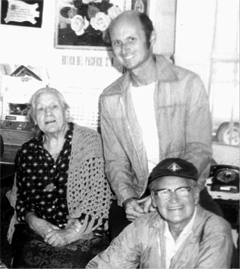Sitting in her simple wooden chair, Doña Luz Corral de Villa, widow of Pancho Villa, began a rambling discourse on her life with the famous—or infamous—bandit, general, and hero of the Mexican Revolution.
 |
The year was 1974, seven years before her death, when I first met Mrs. Villa. My father and I were touring Copper Canyon, and we were introduced to her at her home in the city of Chihuahua.
Sharing her memories with us, eighty-two year old Doña Luz told us of her life as a child, living with her widowed mother in the town of San Andres. One day, when she was a teenager, Villa and his soldiers rode in and demanded monetary contributions from the townspeople. Her mother asked to be excluded, and Villa visited her small store to see if she was really as poor as she claimed to be. There he met Luz. The courtship was very brief, and over the objections of her mother, Luz married Villa. The attending priest asked Villa to make his confession. The General refused, stating that it would take days to list all his sins.
Luz was not the only woman in Villa’s life. He was linked with several in bogus marriages, but later Luz was able to produce a valid certificate proving that she was his only legal wife.
The couple had one child, a daughter, who died within a few years. Luz had no other children, but she took in children Villa had fathered with other women. Perhaps she felt that he would always return to her, knowing that several of his children were with her. Villa built the quinta (manor) during the Revolution, and Luz lived there until her death in 1981. Villa was assassinated in 1923, and several of his “wives” claimed the manor. The marriage certificate might not have been sufficient to safeguard her claim, but Luz had an important ally, Alvaro Obregon, President of Mexico. During the Revolution, Obregon had visited the Villas at the quinta. There Villa had plotted to have Obregon killed, but Luz had interceded, saving the future president’s life. The favor was not forgotten, and Obregon used his considerable influence to protect Luz’s claim.
Eventually the house became a museum, with Luz the resident caretaker, and she tried personally to meet each visitor. Luz traveled through Mexico and the United States, and in Los Angeles received the key to the city.
Shortly before her death she wrote a book about her life with Villa, Pancho Villa: an Intimacy, published by Centro Librero La Prensa, in the city of Chihuahua. In it she loyally defends Villa against most of the accusations against him for his many excesses while leading the Army of the North. While this book must be read with a skeptical eye, her account provides interesting insights into Villa and the Revolution.
The above story was written by Don Fuchik (1941-2004). A long-time travel consultant and guide for The California Native, Don was also my close friend for 51 years. Don held a Master’s Degree in Latin American history and received grants from the National Endowment for the Humanities for his studies of this region.
Lee Klein

Wow, by coincidence I also visited Luz Corral in 1974, it was in December, quite a lady. When Villa died, he left 4 legitimate widows, different holdings were divided with Luz getting Quinta Luz. If memory serves me right a quinta was a fifth of a piece of land which would be used to build the main hacienda building. I do not recall all details but that is more of less the way it went. Quinta later became the name given to a country manor and similar things. Don, by the way was one fantastic man who, on his deathbed made certain his wife sent money to help people of the Sierra–you were lucky to have known him.
Doug “Diego” Rhodes
Hotel Paraiso del Oso
I read your article about your visit to Sra. Luz Corral Villa. My Aunt Margret was a very close friend of Luz Villa and they [frequently corresponded] during the years before their deaths.
They first met in Chihuahua, Mexico, and it was around the period when the Villas lost their daughter. My aunt was not adopted by the Villas but she was favored by them because of the close relationship that my grandfather, Mr John Jones, and my grandmother, Libertada Morales [had with the Villas]. As the story goes, Pancho once saw my Aunt Margret on a rocking horse and asked her if she liked horses and of course my aunt answered “Yes, I love horses.” The following day Pancho Villa showed up at my grandfathers house with a black pony for my aunt.
Throughout the years, Luz Villa and my Aunt Margret kept correspondence and passed Christmas cards and letters back and forth. The orignal letters are safeguarded by my uncle who is now 84 years old and living in Southern California.
With best regards,
Richard D Hilbert
My grand mother’s brother, Ricardo Gonzales, rode with The General Pancho Villa. In the Military Classics Illustrated (News Letter) there is a photo of My great uncle Ricardo on horseback along with Pancho Villa and about 5 or 6 other riders. My uncle is to Pancho Villas left. I have a photo of my uncle with Mrs Pancho Villa (Dona Luz) taken at La Quinta Manor where she lived until her death. The Villa’s manor is a museum in Chihuahua, MX. In the Military Classics Illustrated along with the photo of my uncle with Pancho Villa there is an article titled, The Villistas: Soldiers in Sombreros and Suit Coats By Don Fuchik.
My Grandfather rode with Pancho Villa (Bessie Quijada is my cousin) I have a picture with Luz Villa my Grandfather (Ricardo Gonzalez) and father Gustavo Gonzalez, I always remember that day the photo was taken ,I was about 6 years old and remember playing in the house while grandfather and Mrs Villa talked, there was also an old car at this house that is said to belong to Pancho Villa.